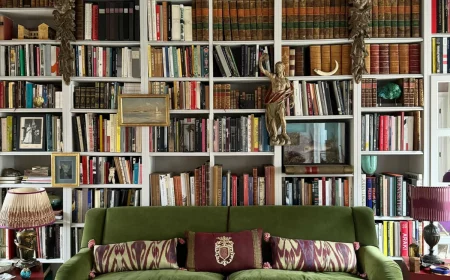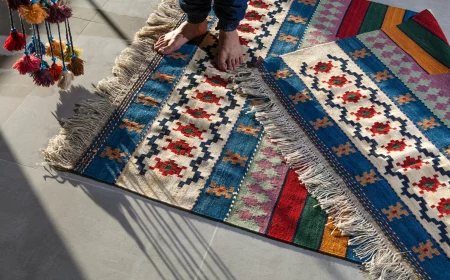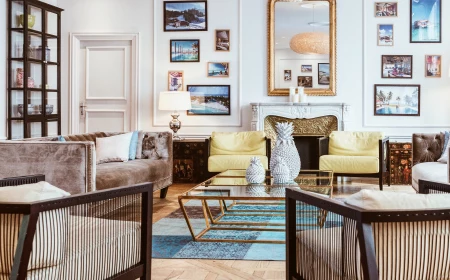Your Living Room Feels… Off? Here’s How the Pros Actually Fix It
I’ve walked into more living rooms than I can count, and honestly, most people get stuck on the same few things. You know the look: all the furniture is clinging to the walls for dear life, the only light source is a glaring overhead fixture, and even though you have nice stuff, the whole room just feels… off. It’s missing that comfortable, put-together vibe.
In this article
- First Things First: Understanding Your Space and Flow
- How to Arrange Furniture Like a Pro
- Let There Be Light (The Right Kind)
- Texture, Materials, and a Sense of Place
- Where to Spend Your Money (and Where to Save)
- Putting on the Finishing Touches
- The Boring but Critical Stuff: Safety and When to Call for Help
- Inspiration Gallery
Forget fleeting trends for a minute. What you really need are the foundational secrets that designers use on every single project, whether it’s a tiny apartment or a massive custom house. These aren’t complicated mysteries; they’re practical techniques that make a room not only look good but feel right.
So, let’s break down how to build a living room from the ground up, focusing on the stuff that actually works and lasts.
First Things First: Understanding Your Space and Flow
Before you even think about adding a new sofa to your online cart, grab a measuring tape and a notepad. The most gorgeous couch in the world is a total nightmare if it blocks the natural flow of your room. This is less about decorating and more about the simple physics of how people move.
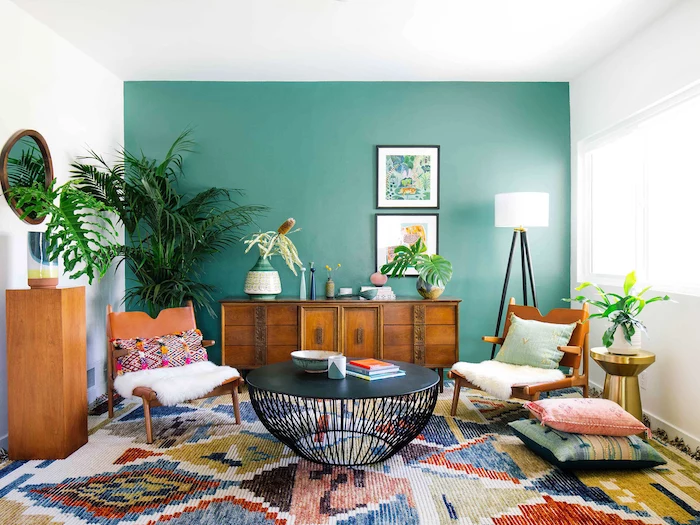
Map Your Walkways
Think about how you move through the room. Where are the doorways? How do you get from the hall to the sofa, or from the sofa to the window? These are your traffic paths, and they need to stay clear. A major walkway—like from one door to another—should be about 36 inches wide. That’s enough room for people to pass without doing that awkward side-shuffle.
For smaller paths, like the space between your coffee table and sofa, about 18 inches is the sweet spot. It’s close enough to set down a drink but gives you enough legroom to not feel trapped.
Quick tip: Use painter’s tape on the floor to mark out the exact dimensions of furniture you’re considering. Live with those blue rectangles for a day. You’ll know very quickly if that giant sectional is a brilliant idea or a future daily annoyance.
The Power of Empty Space
What you leave out of a room is just as important as what you put in. Seriously. Those empty areas, what designers call negative space, are crucial. They give your eyes a place to rest and prevent the room from feeling chaotic and small.
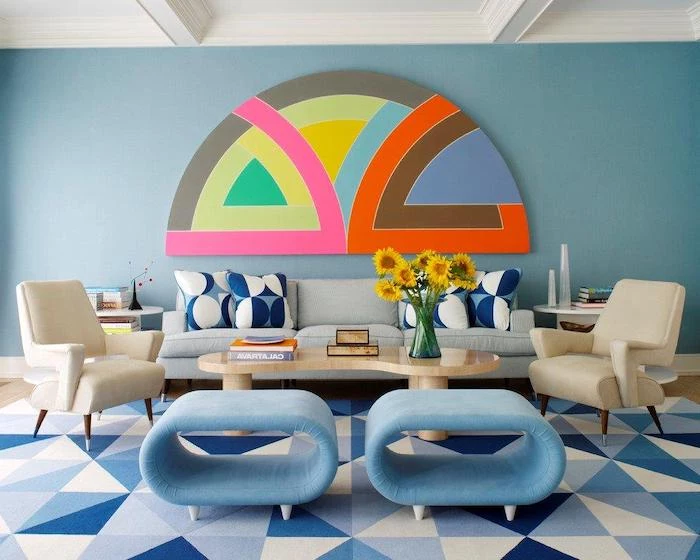
A common mistake is feeling like you have to fill every single corner. Don’t! An empty corner isn’t a failure; it’s a confident design choice that lets your key pieces shine. Think of it like music—the pauses between the notes are what create the rhythm. Without them, it’s just noise.
Getting the Scale Right
Scale is about the size of your furniture relative to the room itself, and proportion is about how pieces look next to each other. A tiny, delicate sofa will look completely lost in a room with high, vaulted ceilings. On the flip side, a massive, overstuffed armchair will totally overwhelm a small den.
Pay attention to the room’s built-in features. If you have low ceilings, look for low-profile furniture—sofas and tables that sit closer to the ground. This simple trick creates an illusion of height. For tall rooms, you can go bigger with a tall bookcase or a large-scale piece of art to draw the eye up and make the space feel balanced.
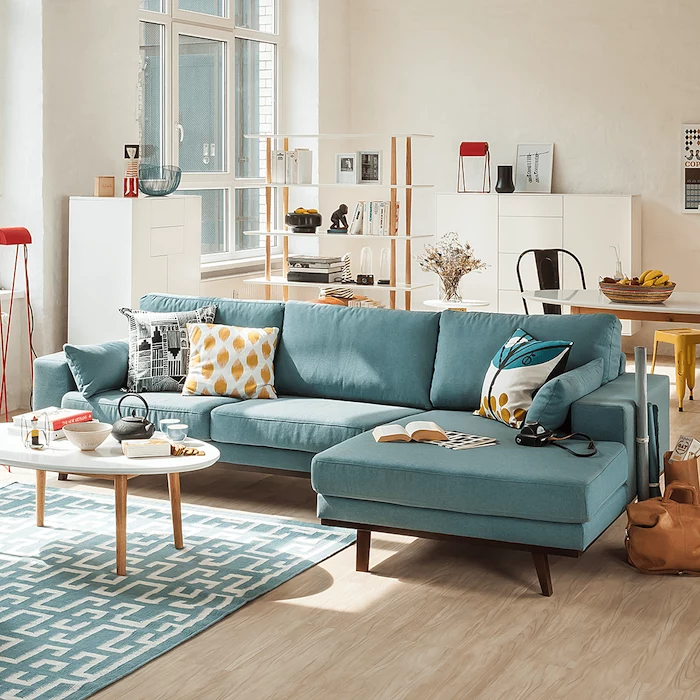
How to Arrange Furniture Like a Pro
Okay, with the space mapped out, it’s time to place the furniture. The goal is to create inviting, functional zones. And yes, this means it’s time to break the habit of pushing everything against the walls.
Start with Your Anchor Piece (and Solve the TV Dilemma)
In most living rooms, the sofa is the star player. It’s the biggest piece, so its placement determines everything else. The first question to ask is: what’s the focal point? Is it a fireplace? A big window with a great view? Or the wall where the TV is going?
Oh yeah, the age-old battle: the fireplace versus the TV. It’s the most common layout problem people face. Here are your options:
- Pick a Side: Place the TV on a separate wall from the fireplace. Arrange your main seating to face the fireplace, creating a primary conversation area, and perhaps place a comfy armchair or two angled toward the TV for viewing.
- Next to the Fireplace: A great compromise is to put the TV on a low media console next to the fireplace. This keeps the focus on one main wall without forcing you to crane your neck.
- Above the Fireplace (The Last Resort): You can mount the TV above the mantel, but heads up: it’s often too high for comfortable viewing and can lead to neck strain. Plus, you have to be very careful about heat from the fire potentially damaging the electronics. If you go this route, get a mount that lets you tilt the screen down.
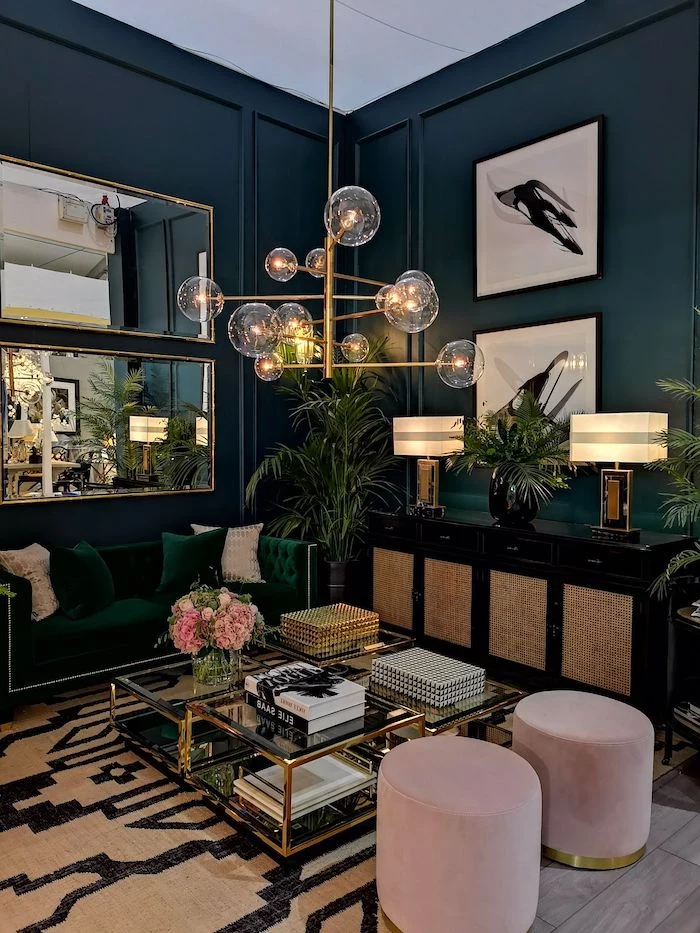
Create Conversation Zones
A living room is for… well, living. That usually means talking with family and friends. Arrange your seating to make conversation easy. A good rule of thumb is to keep seats no more than 8 feet apart. This way, people can talk without shouting across the room. A classic setup is a sofa directly facing two armchairs, with a coffee table in between. It forms a natural, connected group.
Learn to “Float” Your Furniture
Pulling furniture away from the walls is a technique called “floating,” and it instantly makes a room feel more sophisticated and spacious. Even pulling your sofa off the wall by just 4-6 inches creates a little breathing room that makes a huge difference. In a larger room, you can float the entire seating group in the middle, which is perfect for defining the living area in an open-concept space.
Pro tip: Float the sofa and place a slim console table behind it. It’s the perfect spot for a pair of lamps and hides the not-so-pretty back of the couch. Just make sure you leave a clear 36-inch path behind it so it doesn’t become an obstacle.
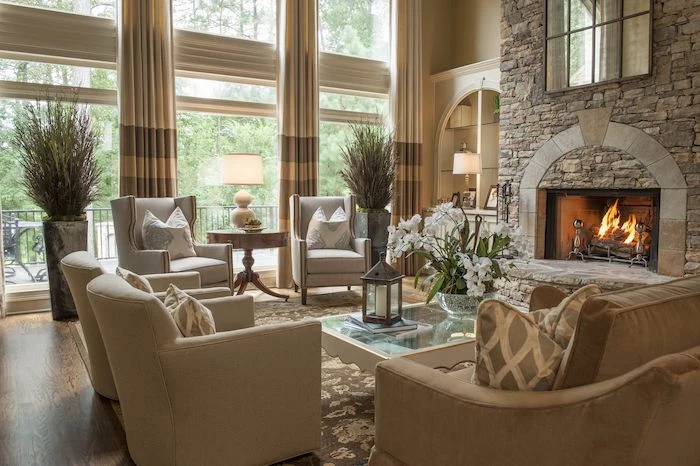
The Most Common Mistake: The Rug
A rug is what grounds your seating area and pulls everything together. But a rug that’s too small is a classic rookie mistake—it makes your furniture look like it’s stranded on a tiny desert island.
Here’s how to get it right:
- Front Legs On: This is the go-to, can’t-fail option. The rug should be large enough for the front legs of your sofa and all your chairs to rest comfortably on it. This ties everything together beautifully. For an average 12×15 foot living room, an 8×10 or 9×12 foot rug is usually perfect for this.
- All Legs On: If you have a larger room and budget, a rug that’s big enough for all your furniture to sit entirely on top of it feels incredibly luxurious. Just be sure to leave about 18 inches of bare floor around the edges of the room.
- Just the Coffee Table On: To be frank, I almost always advise against this. It usually makes the space feel disjointed and small. If you’re on a tight budget, it’s better to save up for a properly sized rug.
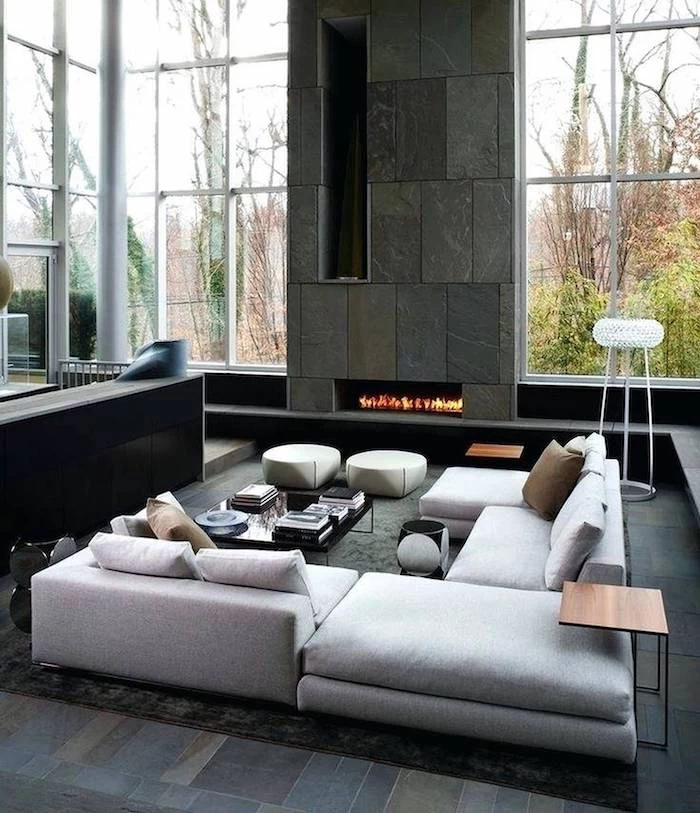
Let There Be Light (The Right Kind)
I cannot overstate this: good lighting changes everything. It sets the mood, helps you see what you’re doing, and can even make a room feel bigger. Relying on a single ceiling light is a recipe for a flat, sad-looking room. The secret is to use layers.
Here’s your foolproof living room lighting recipe:
- Start with Ambient Light: This is your general, all-over light. It could be a central chandelier, recessed lights, or a stylish flush-mount fixture. The key here is to put it on a dimmer switch. Non-negotiable! Dimmer switches are cheap—a pro can install one for $150 to $400, and it gives you complete control over the mood.
- Add Task Lighting: Next, add focused light for specific activities. A floor lamp next to your favorite reading chair, or a small lamp on a side table. This prevents eye strain and makes the room way more functional.
- Finish with Accent Lighting: This is the fun part! These are the lights that add personality. Use a small spotlight to highlight a piece of art, or place a little uplight behind a plant to create cool shadows. It adds depth and makes the room feel dynamic.
Aim for a warm light color, somewhere between 2700K and 3000K on the color temperature scale. It mimics cozy, classic light bulbs and is much more flattering than cool, blue-toned light.

Texture, Materials, and a Sense of Place
A great room is about more than just what you see; it’s also about what you feel. Texture is what makes a room feel like a comfortable home instead of a sterile showroom. The trick is to mix it up.
Imagine a smooth leather sofa paired with a chunky knit throw blanket. Add a rough, reclaimed wood coffee table and some soft velvet pillows. The contrast between smooth, rough, soft, and hard is what creates interest. It’s a sensory experience.
By the way, here’s a fun little challenge: Pause for a second and look around your living room. Can you spot at least five different textures? (e.g., smooth glass, rough wood, soft fabric, shiny metal, a natural fiber). This simple exercise will get you thinking about your space in a whole new way.
Where to Spend Your Money (and Where to Save)
You don’t need an unlimited budget to create a beautiful living room. It’s all about being smart with your money. I’ve learned there are a few key places to invest and plenty of areas where you can save.
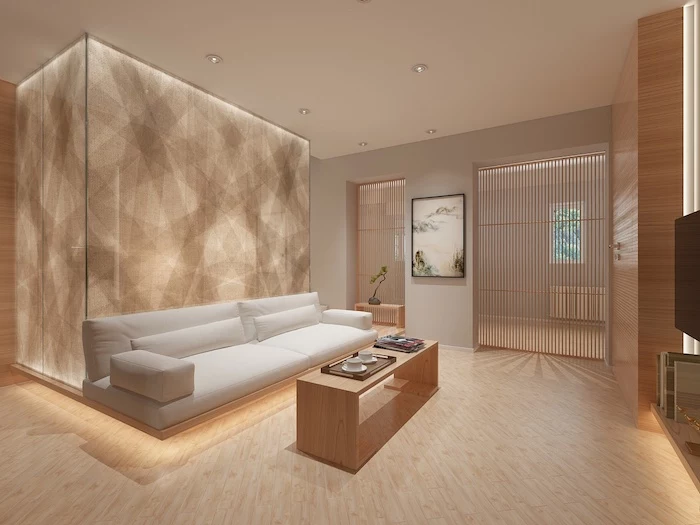
Splurge Here: The Sofa
Your sofa is the workhorse of your living room. You sit on it, nap on it, and entertain on it every single day. This is not the place to cheap out. A quality sofa that will last you a decade or more can cost anywhere from $2,000 to $5,000, but it’s worth it. Look for key features like a “kiln-dried hardwood frame” (which prevents warping) and “high-resiliency foam” cushions that won’t turn into sad pancakes after a year.
Save Here: Accessories and Side Tables
On the other hand, you can find incredibly stylish and affordable side tables, coffee tables, lamps, and pillows. These items don’t take the same daily beating as your sofa. This is also the perfect area to play with trends. A $30 pillow cover from Etsy or a trendy vase from Target is a low-risk way to keep your room feeling fresh without breaking the bank.
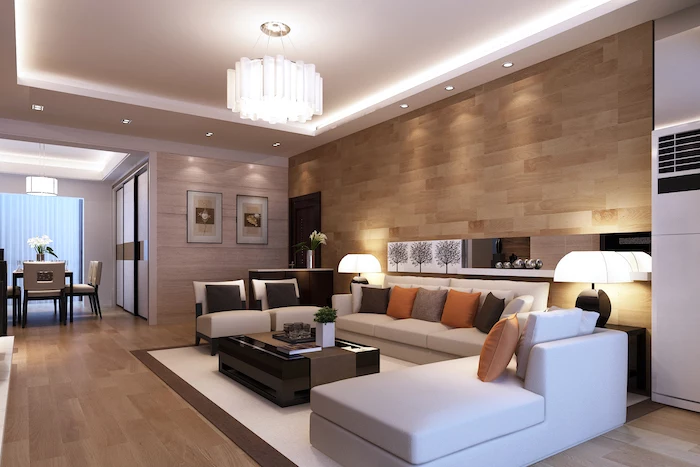
Putting on the Finishing Touches
Once the foundation is solid, a few final details can take your room from good to truly great.
The Rule of Threes
When you’re styling a surface like a bookshelf or coffee table, group items in odd numbers, especially threes. A trio of objects with varying heights and shapes is more visually interesting than a boring, symmetrical pair. For example, try a tall vase, a medium-sized stack of books, and a small decorative bowl.
Mix Old with New
A room where everything is brand new from the same store can feel a bit soulless, like a page in a catalog. The most captivating rooms feel like they were collected over time. From my own experience, I once designed a room that was technically perfect but felt cold and stiff. The solution? A funky, slightly beat-up armchair I found at a flea market for $100. It instantly gave the room a story and a soul.
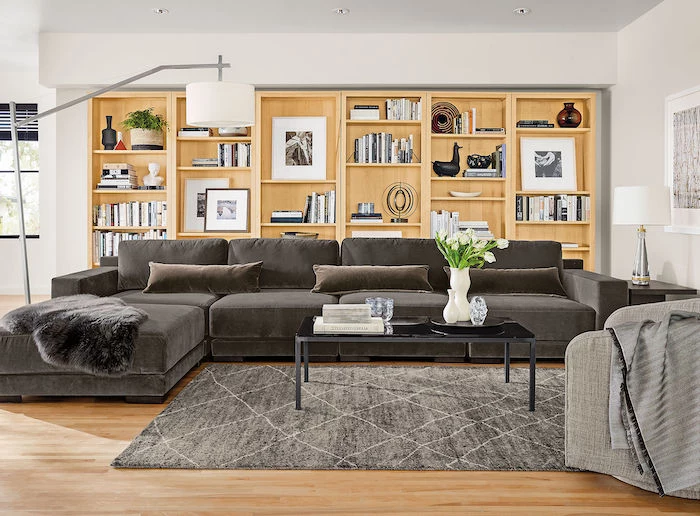
Don’t be afraid to mix a modern sofa with a traditional chest that you use as a side table. It’s this mix that makes a room feel uniquely yours.
The Boring but Critical Stuff: Safety and When to Call for Help
My job isn’t just about making things look pretty; it’s about making them safe. Knowing your limits is the smartest thing you can do for any home project.
- Electrical Work: Don’t even think about it. For installing new fixtures, moving outlets, or even putting in those essential dimmer switches, always hire a licensed electrician. It’s the law in many places and a critical safety measure.
- Anchoring Furniture: If you have kids, anchor all tall furniture like bookcases and media units to the wall. Tip-over accidents are a serious risk, and a safety kit costs less than $20 at any hardware store. It’s the easiest and most important safety task you can do.
- Custom Work & Structural Changes: Want to remove a wall or build some complex custom bookshelves? That’s a job for a pro—a contractor for the structural stuff and a skilled carpenter for high-quality built-ins.
Ultimately, your living room should be a reflection of you. These principles are just a framework to help guide your creativity. The best spaces are the ones that feel authentic and loved. So start with a solid foundation, trust your gut, and have fun creating a room you absolutely love coming home to.

Inspiration Gallery
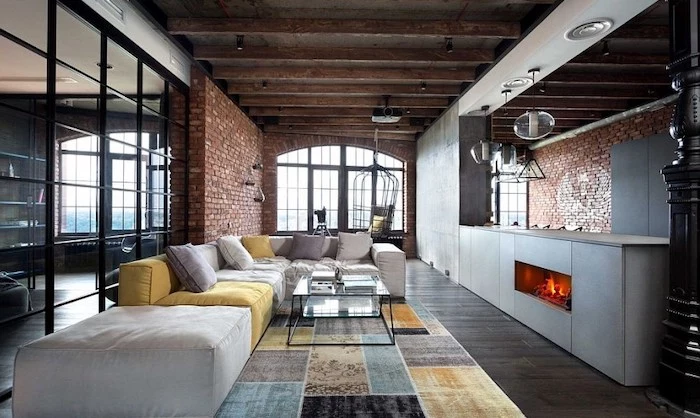
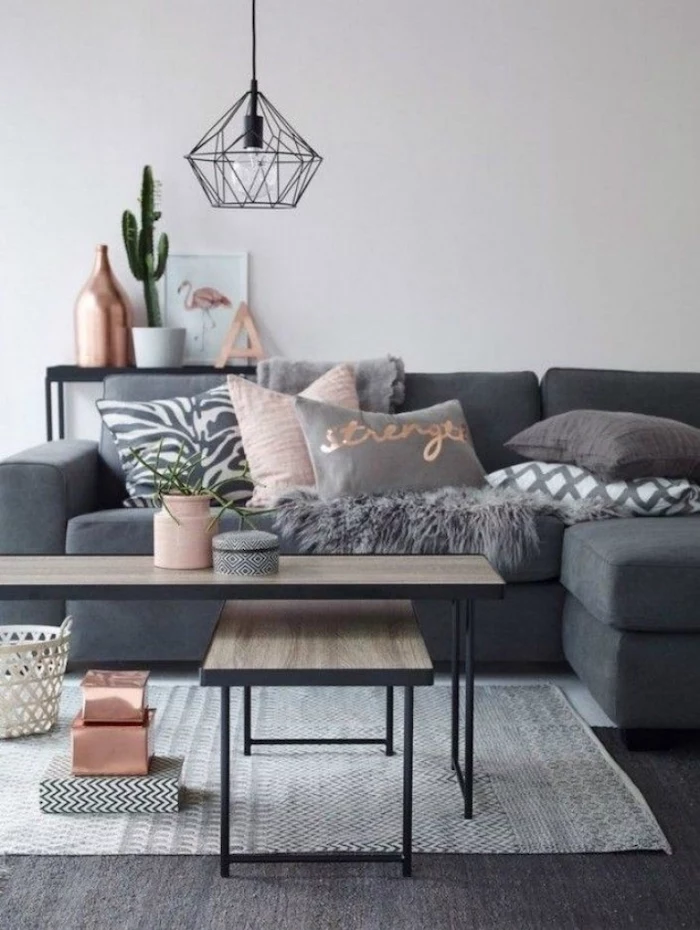
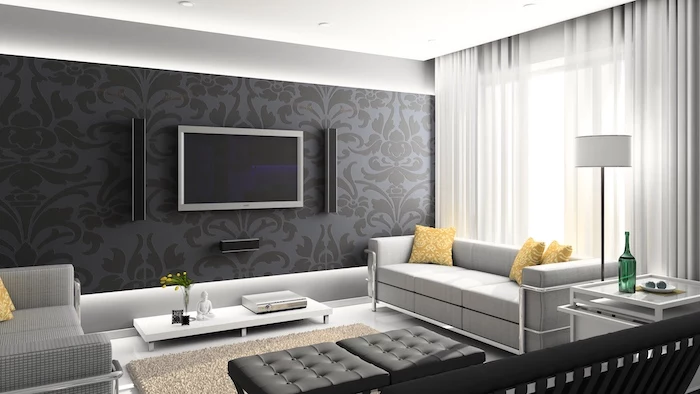
The right area rug doesn’t just match the decor, it creates the foundation for the entire room.
A common mistake is choosing a rug that’s too small, creating a ‘postage stamp’ effect. For most living rooms, the rug should be large enough that at least the front legs of your sofa and armchairs are sitting on it. This visually connects the furniture, making the space feel more cohesive and expansive. Brands like Ruggable or West Elm offer a wide range of sizes to get the scale just right.

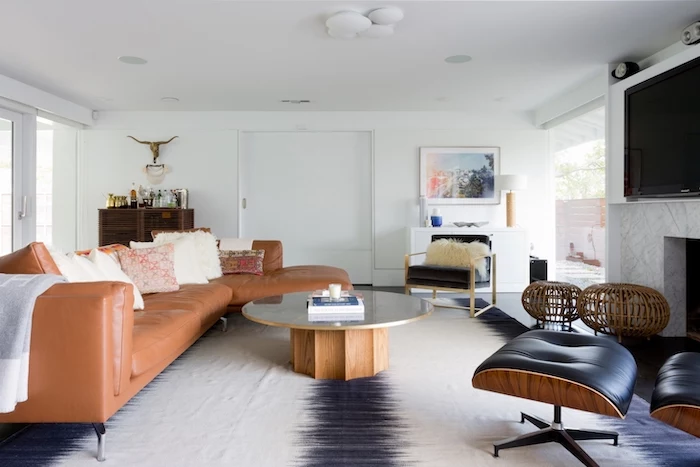
What’s the secret to lighting that feels warm and inviting, not like an interrogation room?
Layering. Pros aim for at least three sources of light in a living room. Start with your ambient (general) lighting, which might be that overhead fixture. Then add task lighting, like a stylish floor lamp next to a reading chair. Finally, bring in accent lighting—a small table lamp on a console, or even picture lights over art—to create depth and mood. The key is to have options you can control with dimmers for ultimate flexibility.
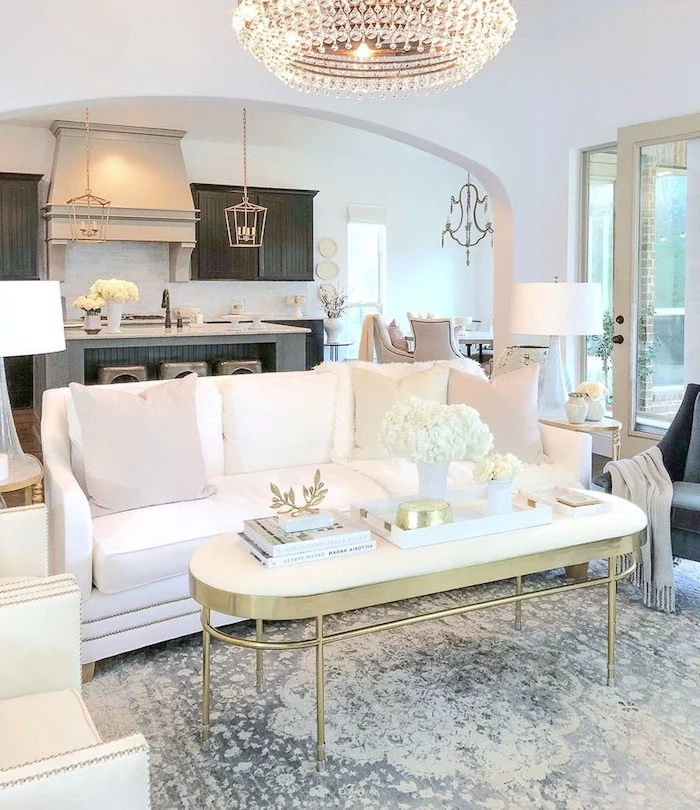
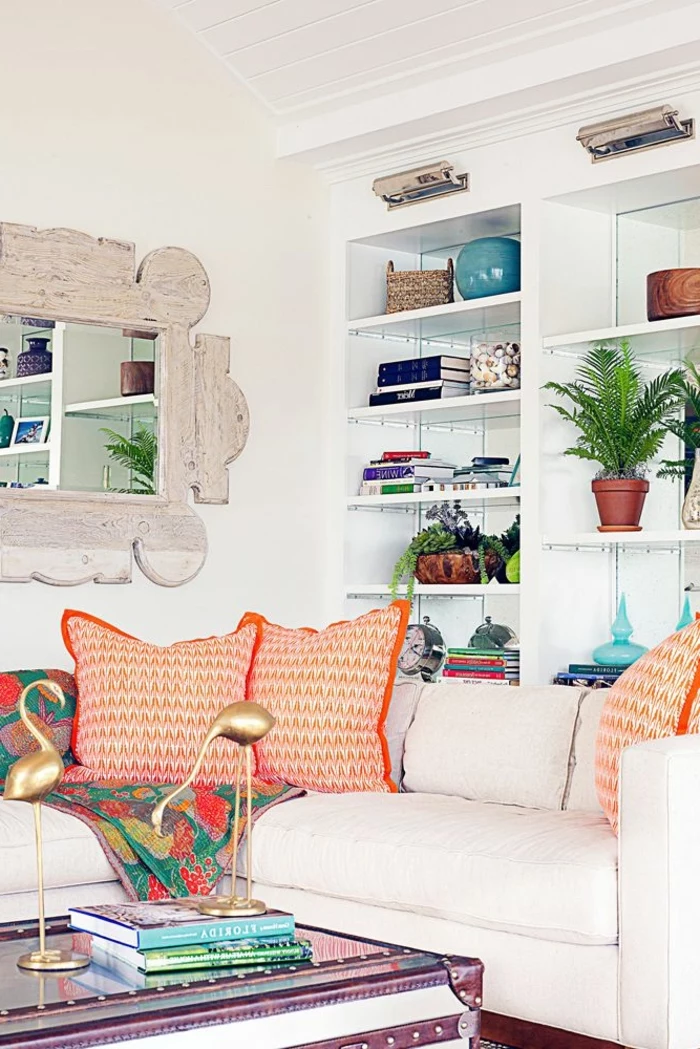
The Coffee Table Dilemma: A square or rectangular table works beautifully with a standard sofa. It mirrors the couch’s linear shape and provides ample surface area.
The Round Alternative: If you have a sectional sofa, young children (no sharp corners!), or a tighter space, a round coffee table is a game-changer. It improves flow and softens the hard angles of other furniture.
Ultimately, let your room’s layout and your lifestyle decide.
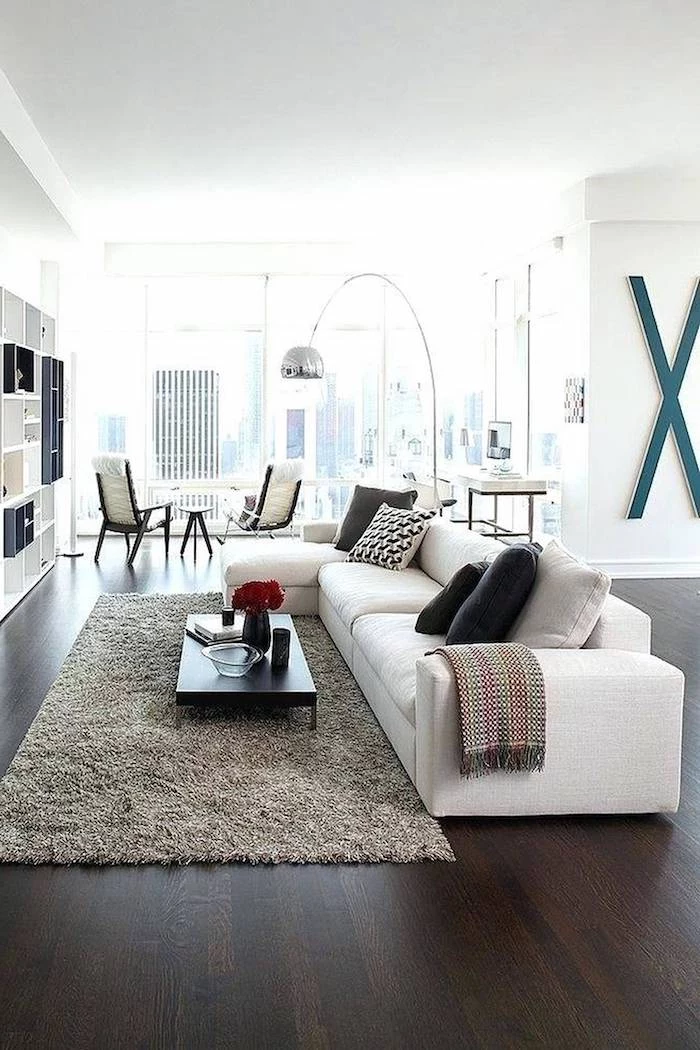
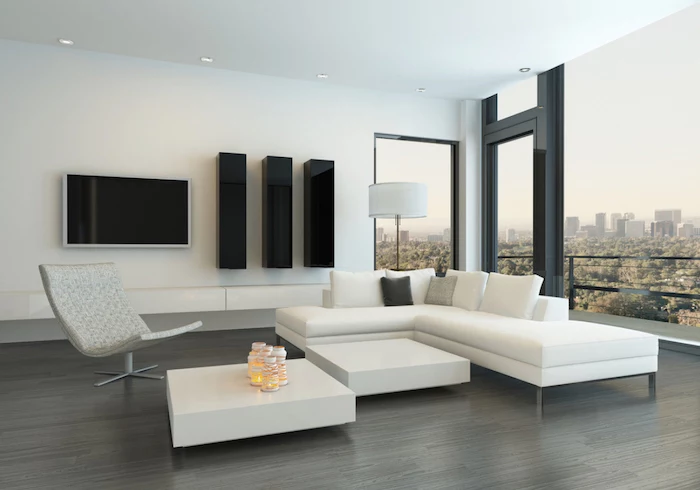
- It introduces a new material and finish.
- It bounces light around the room.
- It creates the illusion of depth.
The trick? A strategically placed large mirror. Lean a full-length floor mirror against a wall or hang a significant circular one over a console or fireplace to instantly make your living room feel brighter and more spacious.
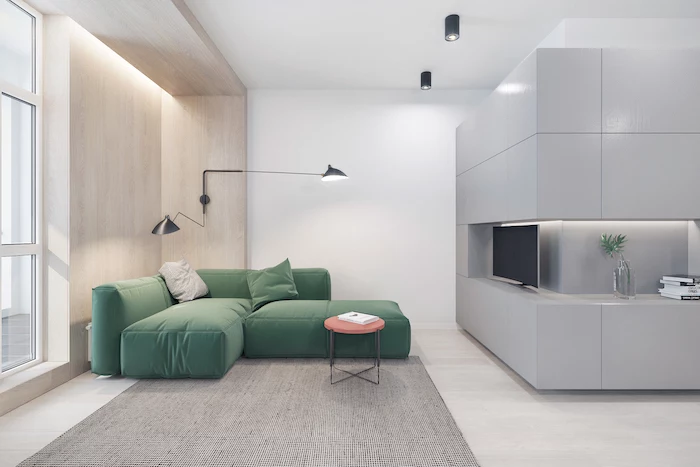
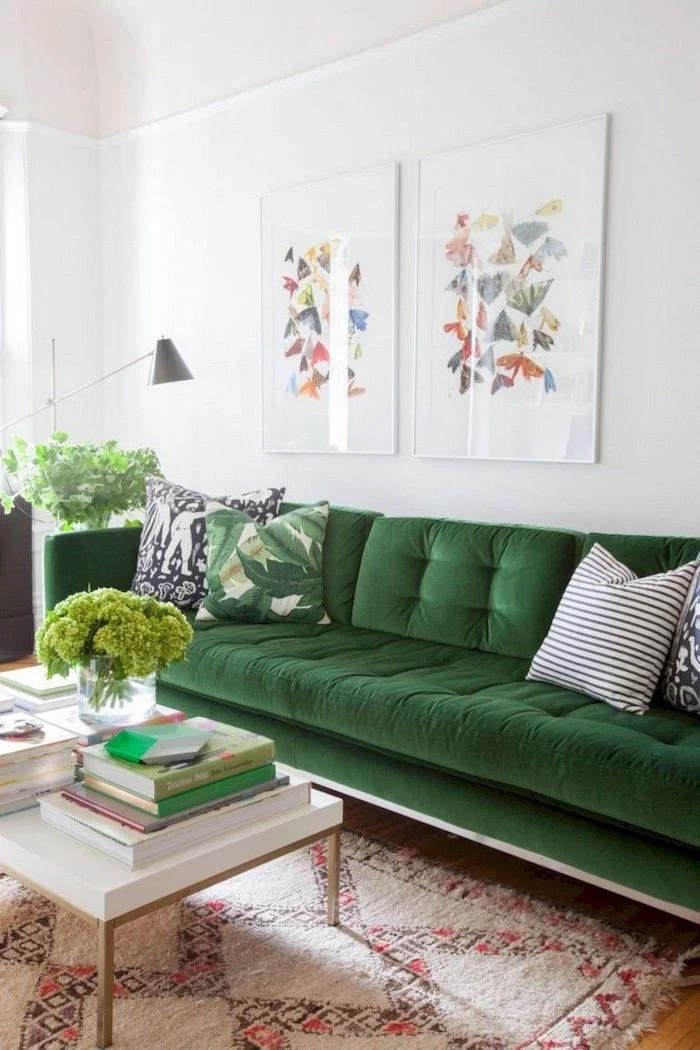
Don’t fall into the ‘matchy-matchy’ trap of buying a complete sofa, loveseat, and armchair set from the same collection. A professionally designed room gets its character from a curated mix. Pair a classic fabric sofa, like the Pottery Barn Pearce, with a cognac leather armchair. The contrast in texture and color adds a layer of visual interest that a pre-matched set can never achieve.

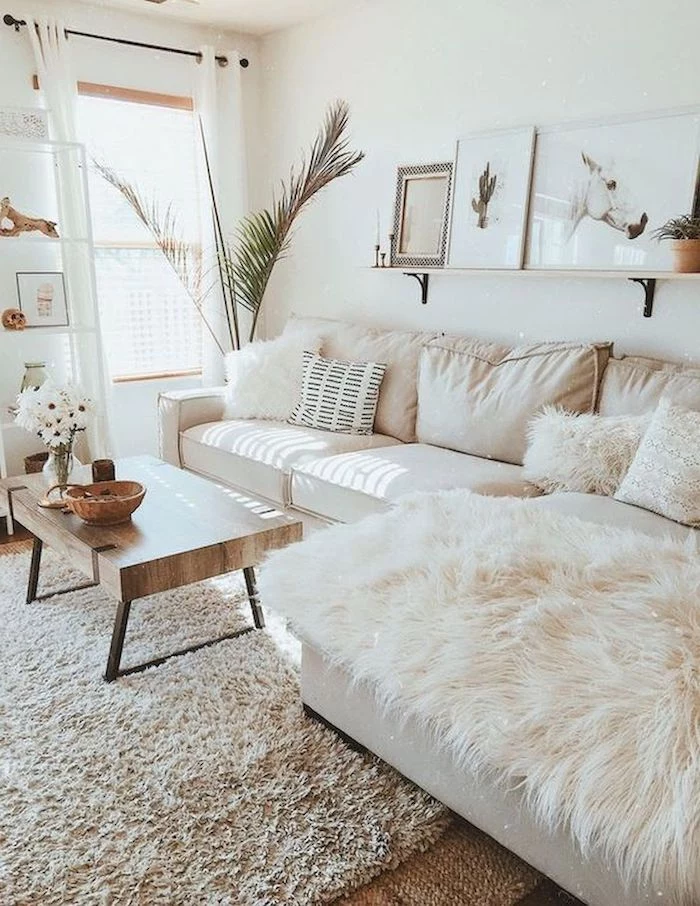
A 2018 study found that interacting with indoor plants can reduce psychological and physiological stress.
Beyond the wellness benefits, plants are living sculptures. A tall Fiddle Leaf Fig can add dramatic height to a corner, while a cascading Pothos on a bookshelf brings softness and life. They are the easiest way to add a natural, organic element to your design scheme.
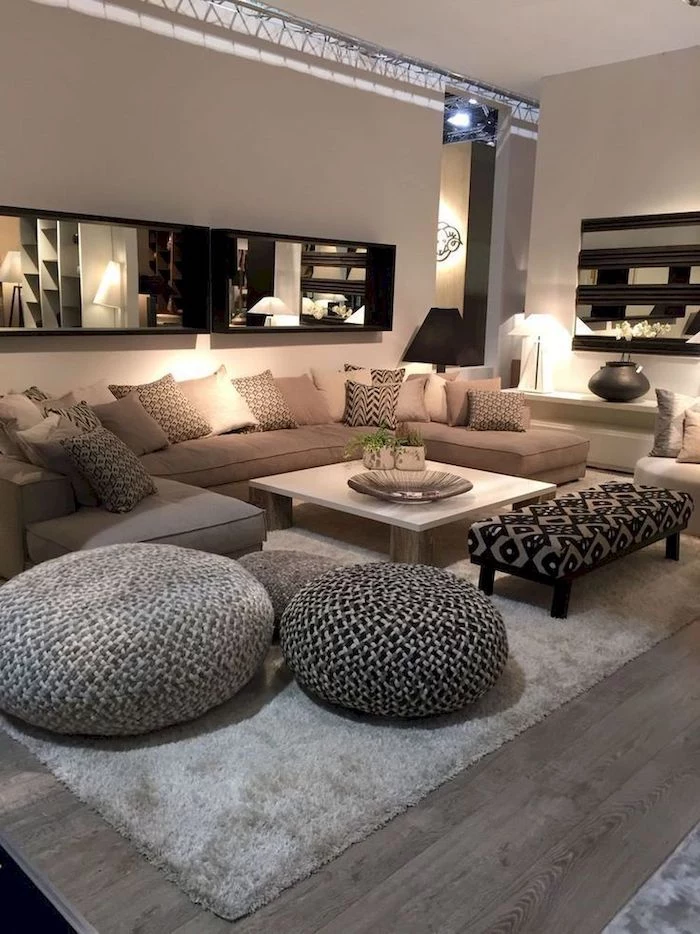
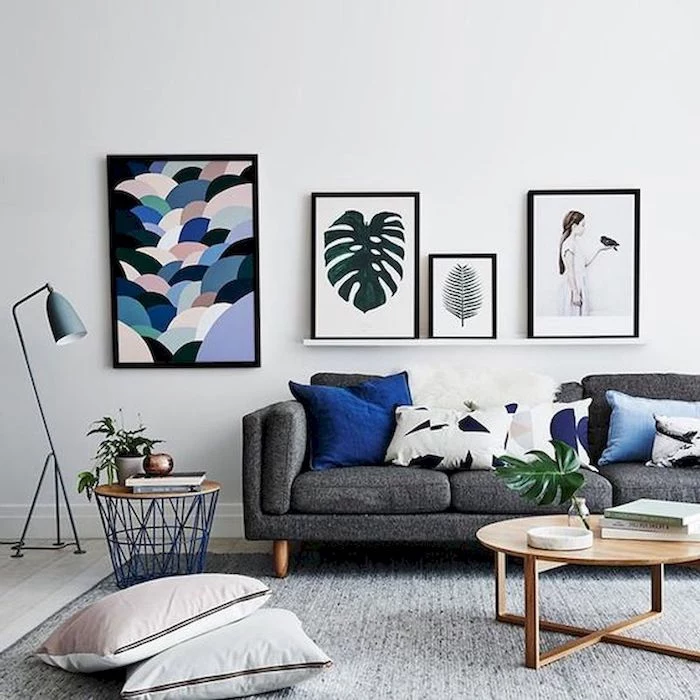
Important point: The height at which you hang art can make or break your design. The center of the artwork (or the center of a gallery wall grouping) should be hung at eye level, which is approximately 57 inches from the floor. This is the standard used by galleries and museums, and it ensures the art relates to human scale, not the ceiling height.
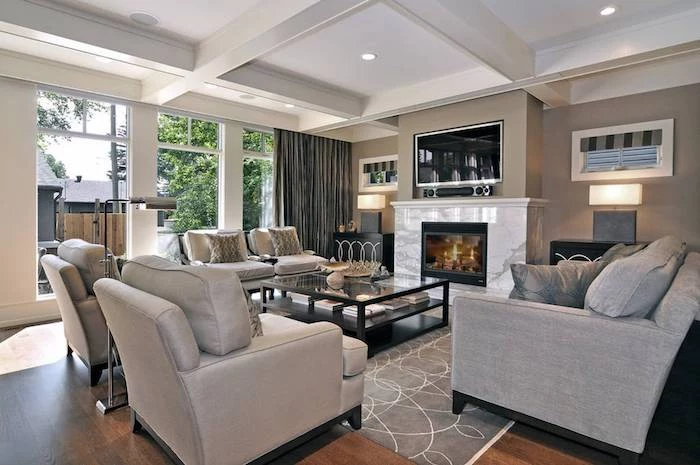
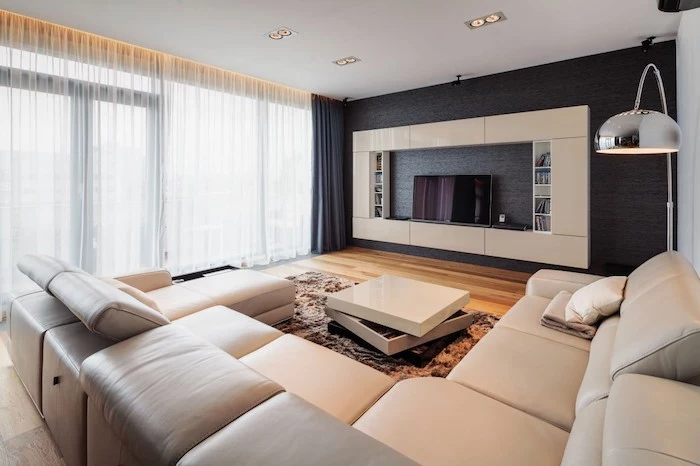
Think beyond paint and furniture. Texture is the unsung hero of a cozy living room. Imagine a space with a nubby bouclé pillow, a smooth leather chair, a chunky knit throw, a rough-hewn wooden side table, and a soft wool rug. This rich tapestry of surfaces is what makes a room feel layered, sophisticated, and deeply comfortable, even in a monochromatic color scheme.
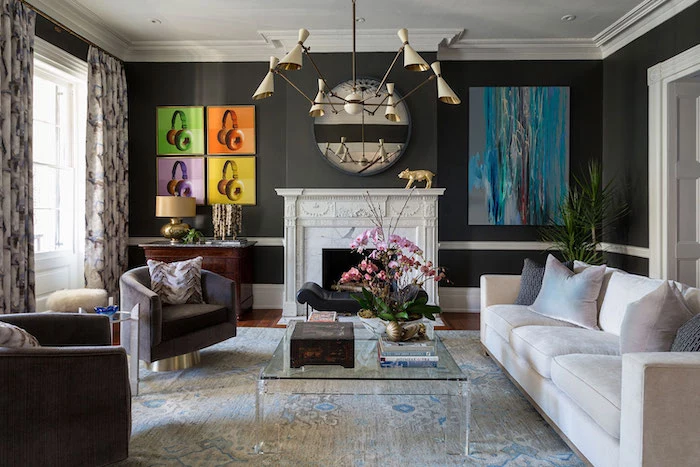

Looking for the perfect, sophisticated neutral? Consider a paint with subtle undertones. Instead of a flat beige, try Farrow & Ball’s ‘Elephant’s Breath,’ which has a hint of magenta that shifts beautifully in the light. For a warmer grey, Benjamin Moore’s ‘Revere Pewter’ is a designer favorite because it bridges the gap between grey and beige, complementing almost any decor.
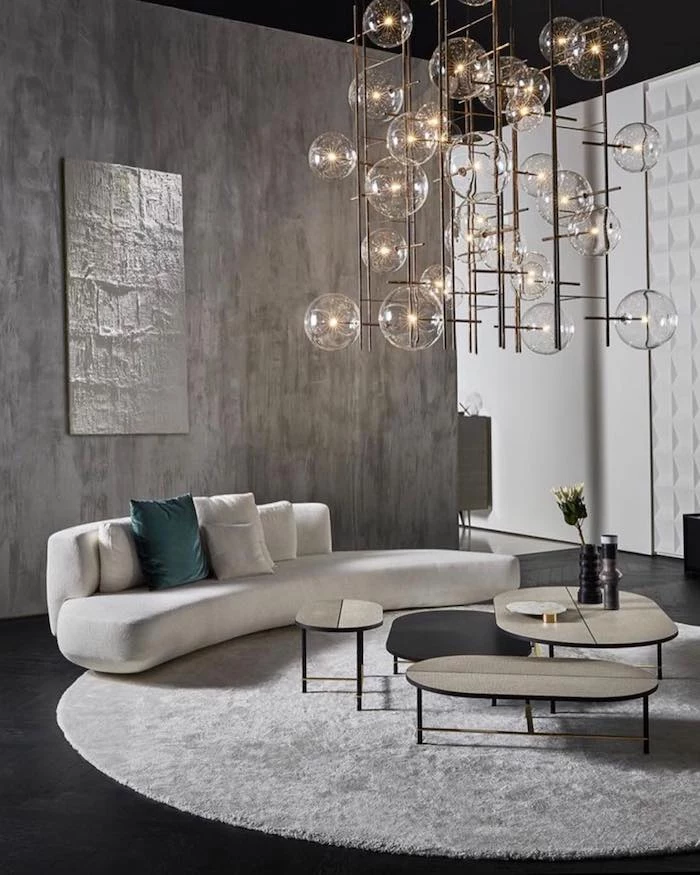
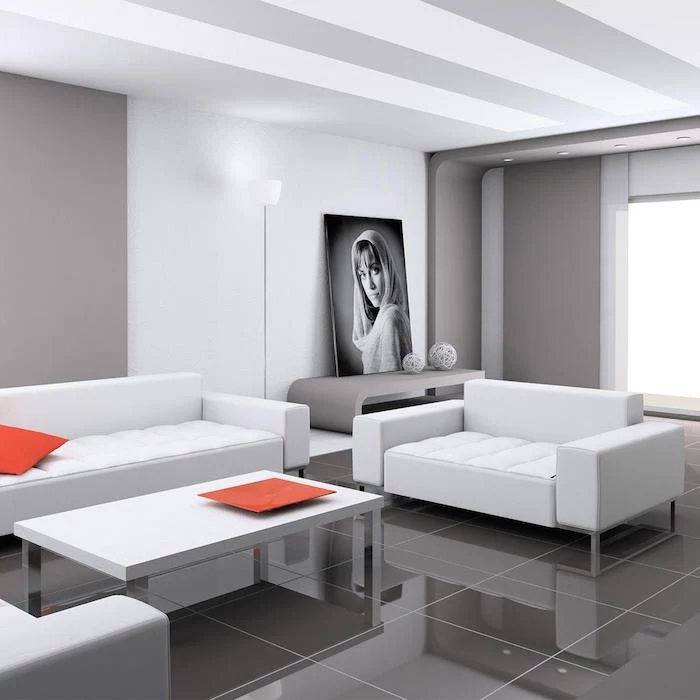
- Hang curtains high and wide. Mounting the rod 4-6 inches above the window frame and extending it 6-10 inches on each side makes the window appear much larger.
- Let them ‘kiss’ the floor. Curtains that are too short look awkward. They should just skim the floor or puddle slightly for a more luxurious feel.
- Choose the right fabric. Sheer linens filter light beautifully, while velvet adds drama and blocks it out.
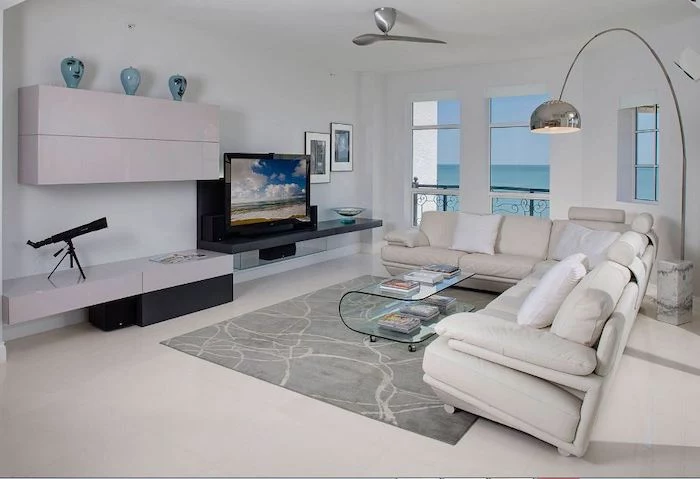
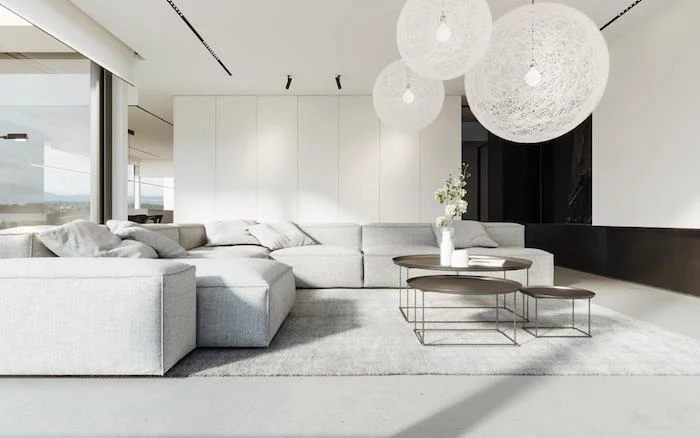
My bookshelf looks cluttered. How can I style it like a pro?
Start by emptying it completely. Then, follow the rule of thirds: 1/3 books, 1/3 objects, and 1/3 empty space. Arrange some books vertically and some horizontally to act as risers for small decorative objects. Mix in personal items like photos, vases, or small sculptures. Step back frequently to assess the balance. The goal isn’t just storage; it’s creating a personal and visually appealing display.
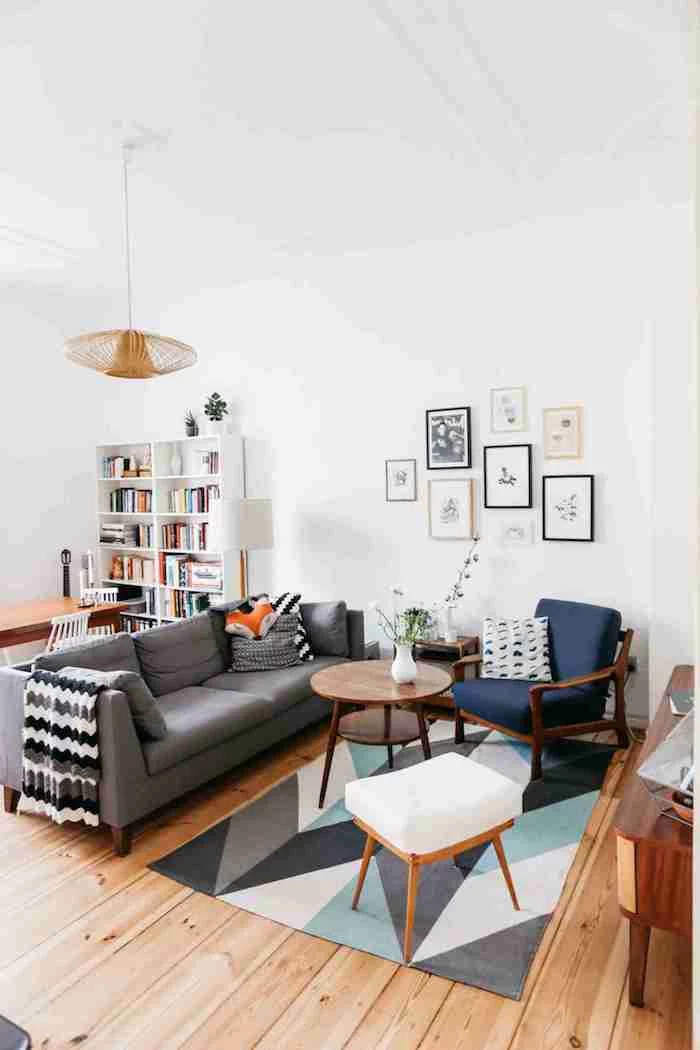
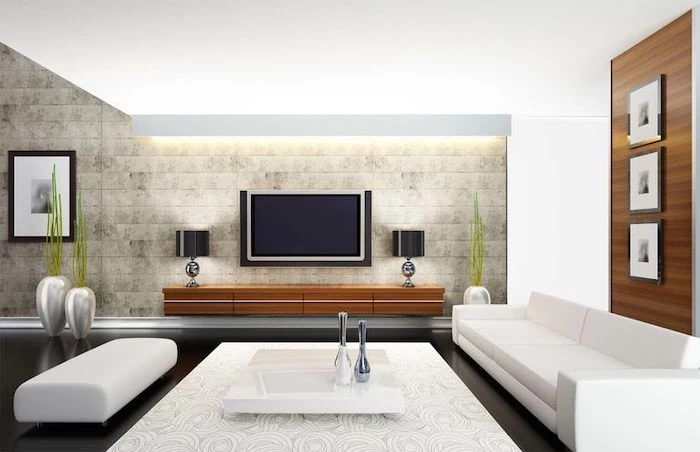
Performance Velvet: Surprisingly durable and often stain-resistant, modern velvets (like those from Joybird or Article) offer a luxe look with family-friendly practicality. They have a rich texture that adds depth to any color.
Natural Linen: Offers a relaxed, airy, and sophisticated vibe. Prone to wrinkling and less stain-resistant, it’s best for more formal or adult-only spaces. Its lived-in elegance is hard to beat.
For a busy household that still wants a touch of glam, performance velvet is the clear winner.
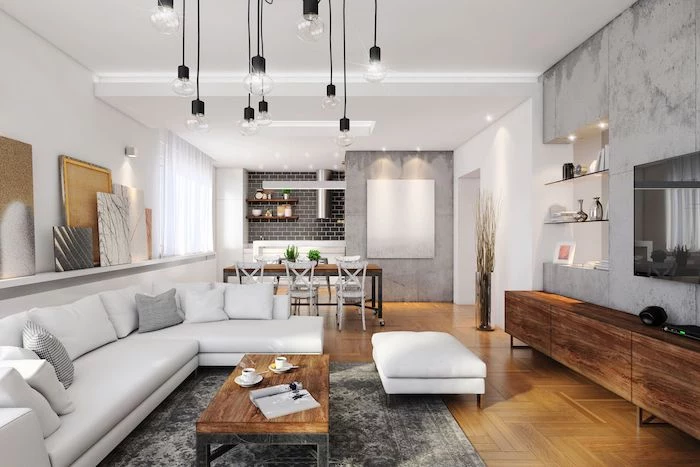
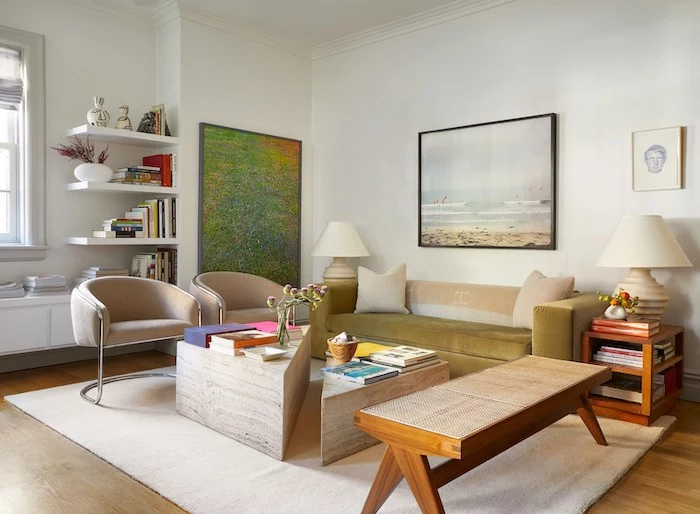
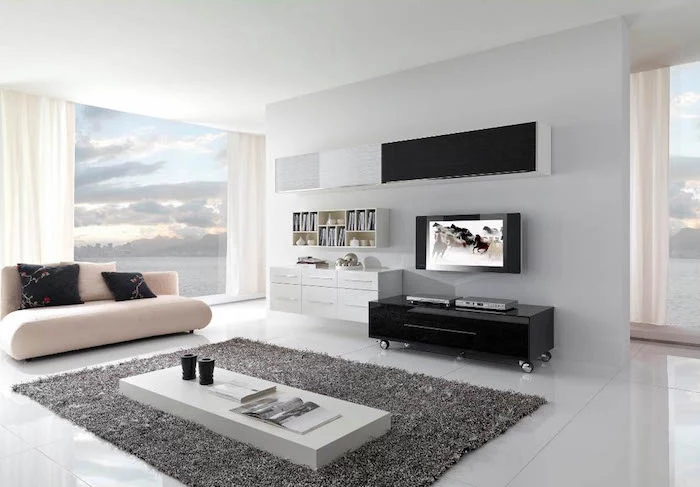
The 60-30-10 rule is a timeless decorating principle for creating a balanced color palette.
- 60% Main Color: This is your dominant shade, likely used on the walls. It sets the overall tone of the room.
- 30% Secondary Color: Used for furniture, rugs, or an accent wall. It should support the main color but be different enough to create interest.
- 10% Accent Color: This is your pop of fun. Use it for throw pillows, art, and accessories. Think of it as the jewelry of the room.
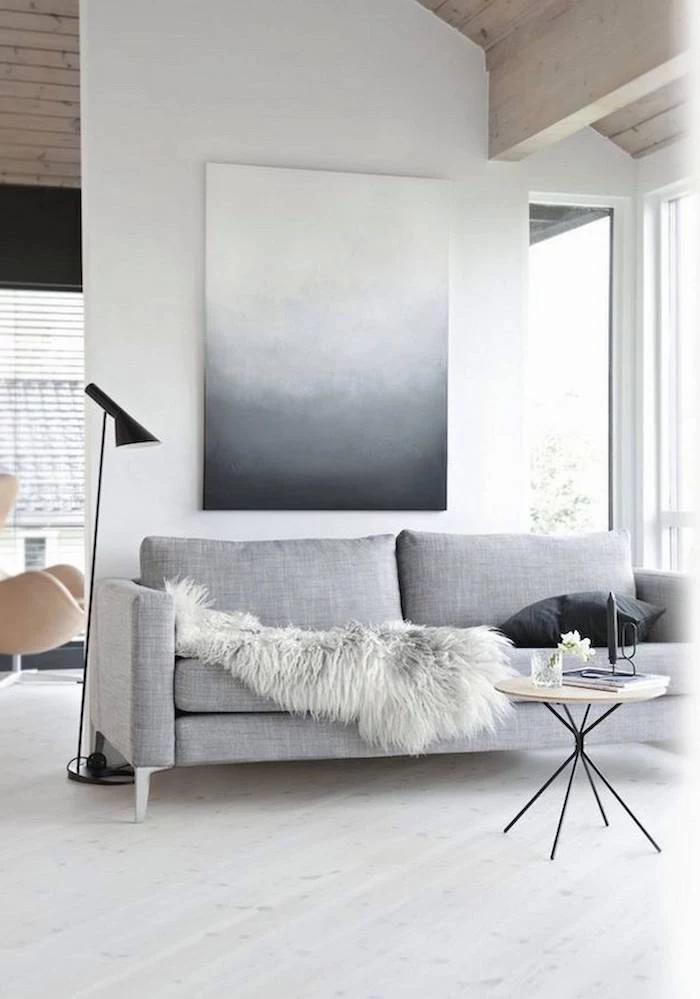
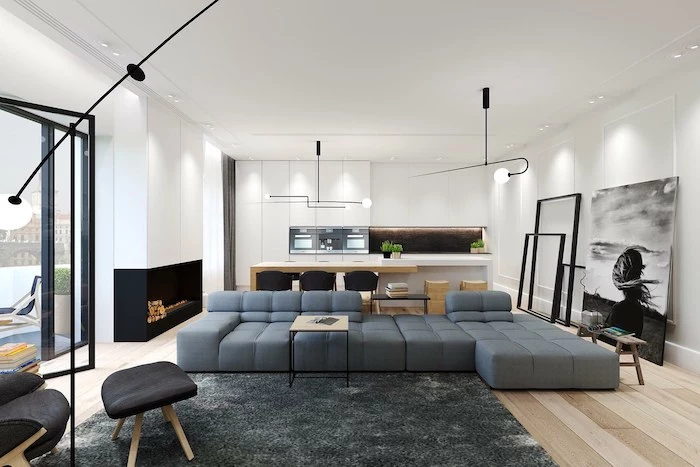
That empty wall is your canvas. A gallery wall tells a story and injects personality. For a cohesive look, use frames of the same color but vary the sizes. For a more eclectic, collected vibe, mix different frame styles, colors, and materials. Lay your arrangement out on the floor first to perfect the spacing before a single nail hits the wall. A great starting point is a large central piece, with smaller items radiating outwards.
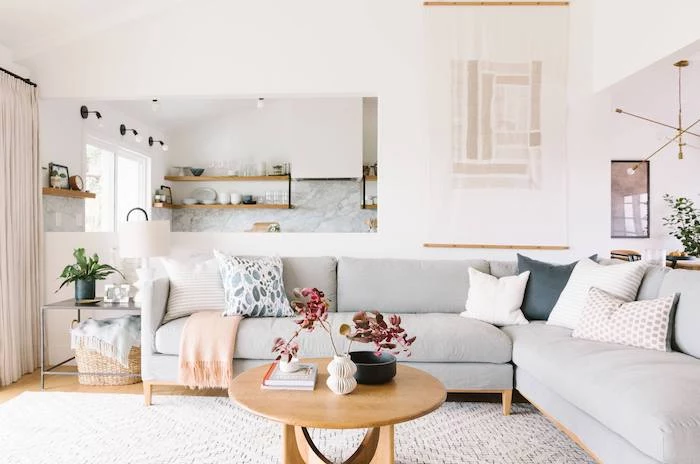

According to a survey by the National Association of Realtors, 83% of buyers’ agents said staging a home made it easier for a buyer to visualize the property as a future home.
What this means for your own living room is that proper arrangement isn’t just an aesthetic choice; it’s a psychological one. A well-placed sofa, a clear path, and thoughtfully chosen accessories help a space communicate its purpose and potential, making it feel more like ‘home’ instantly.
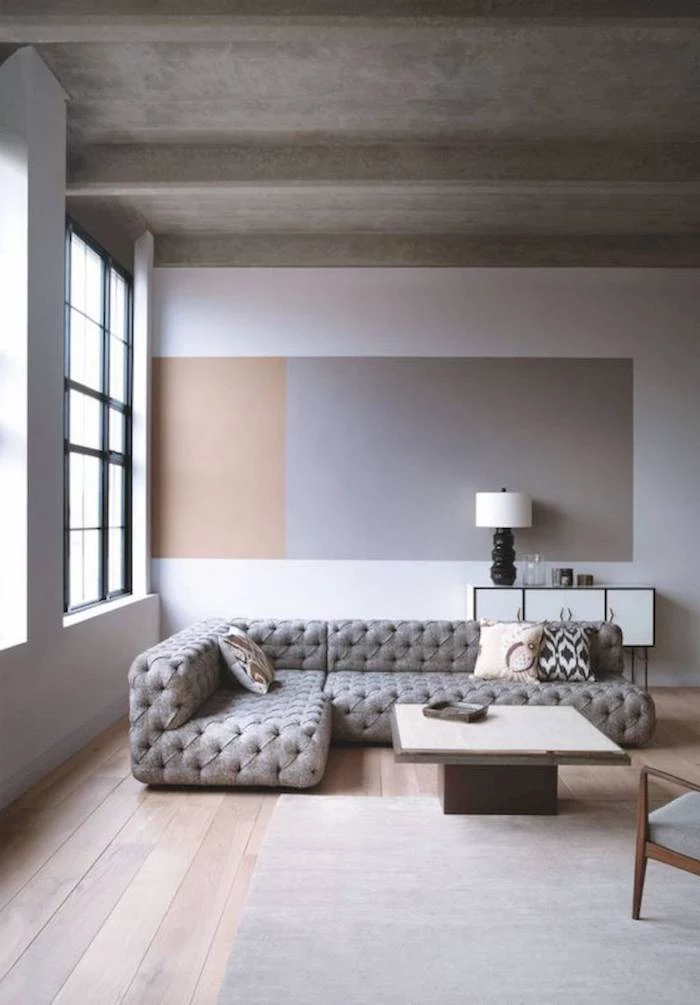
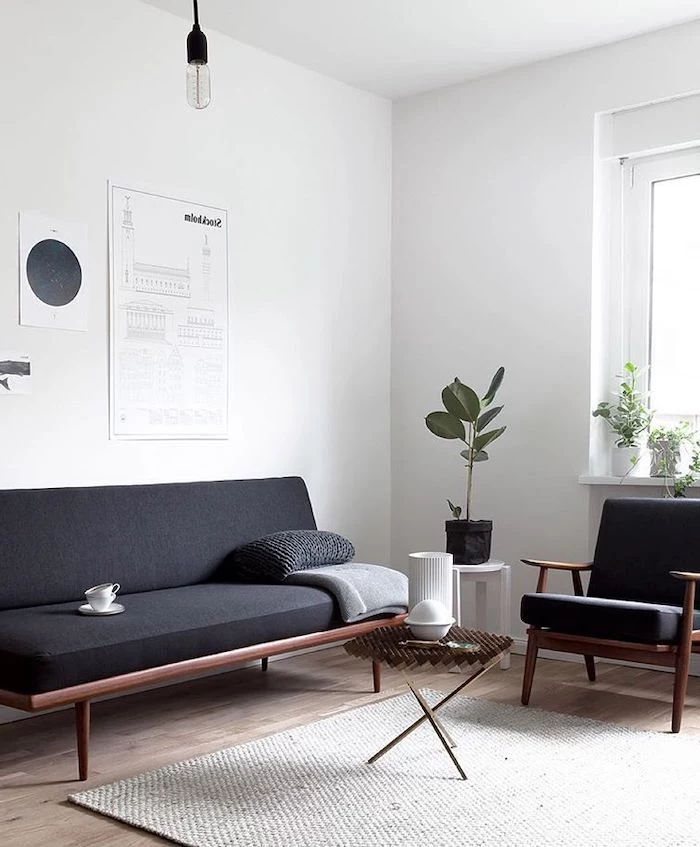
The Final Layer: Scent-scaping. A room’s appeal is multi-sensory. After the visuals are perfect, consider the room’s signature fragrance. It doesn’t have to be overwhelming. A high-quality candle with a complex scent (like Diptyque’s ‘Baies’ or Le Labo’s ‘Santal 26’), a subtle reed diffuser, or even a bundle of fresh eucalyptus can complete the atmosphere, making the space feel truly finished and personal.
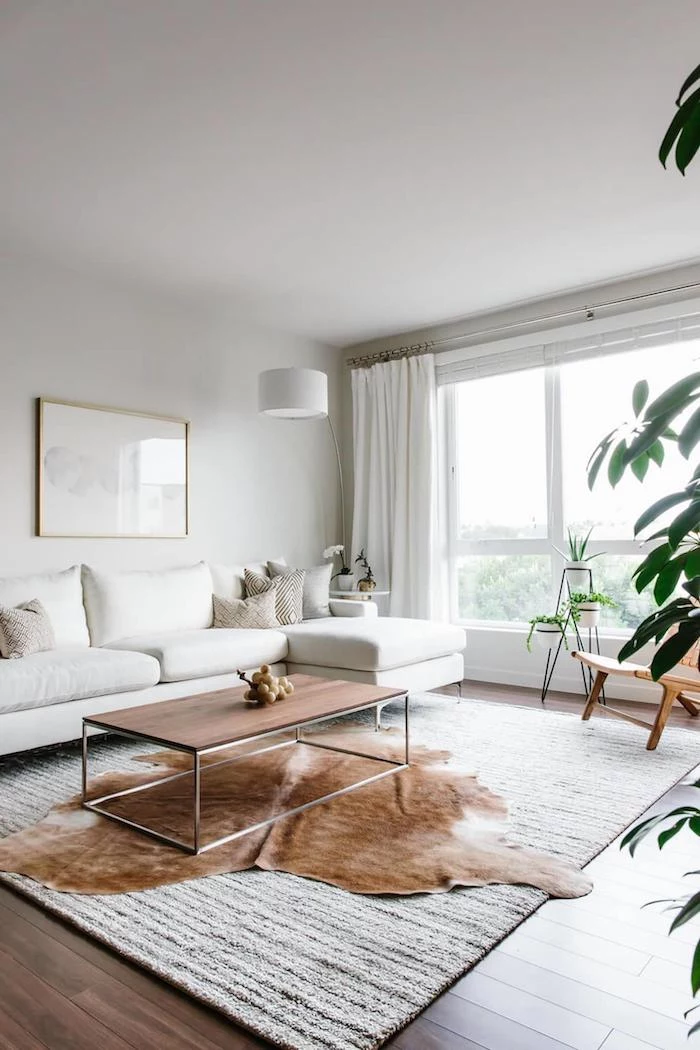
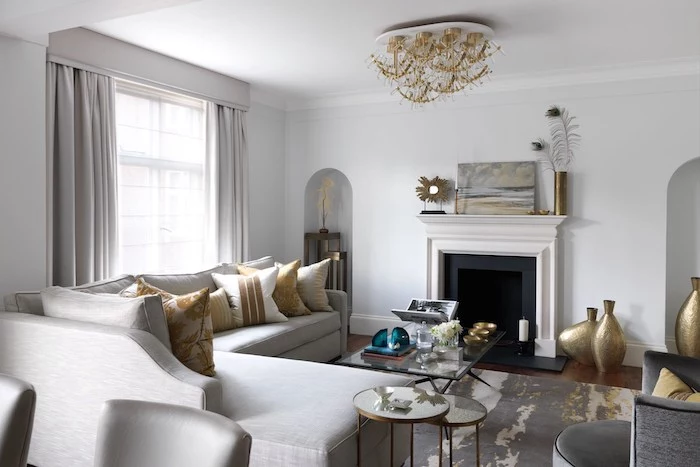
- It can feel cold and impersonal.
- It lacks the charm of a space evolved over time.
- It often forgoes higher quality for a uniform look.
The culprit? The dreaded ‘showroom’ effect. Avoid buying everything from one store, in one style. The most captivating rooms blend periods and provenances. Pair your sleek, modern sofa from Crate & Barrel with a vintage mid-century credenza found on Facebook Marketplace. This mix tells a more interesting story.
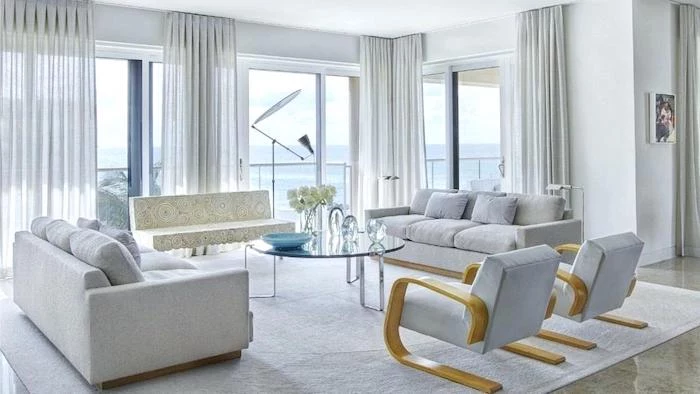
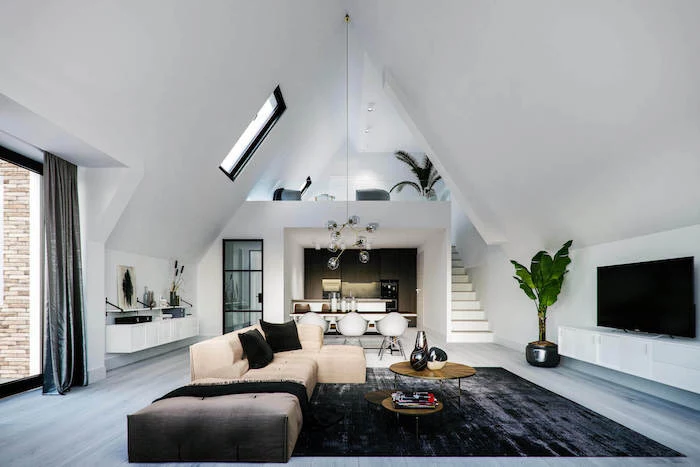
What is ‘Hygge’ and how can I get it in my living room?
Hygge (pronounced hoo-gah) is a Danish concept that encompasses a feeling of cozy contentment and well-being through enjoying the simple things in life. In decor, this translates to creating a warm, inviting atmosphere. Think soft textures like sheepskin throws and wool blankets, the warm glow of candlelight, a stack of favorite books, and comfortable seating that encourages you to linger with a cup of tea. It’s less about a specific style and more about the mood.
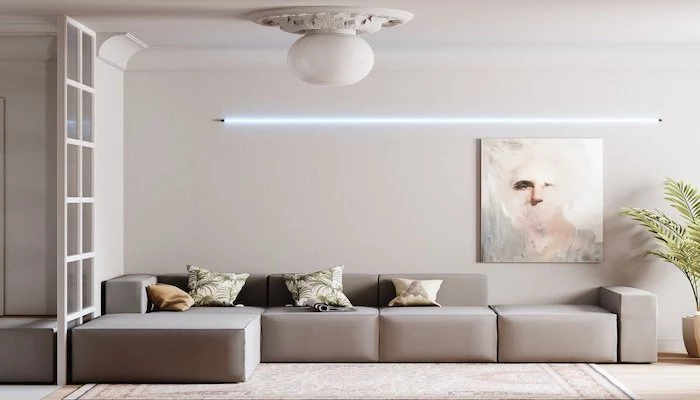
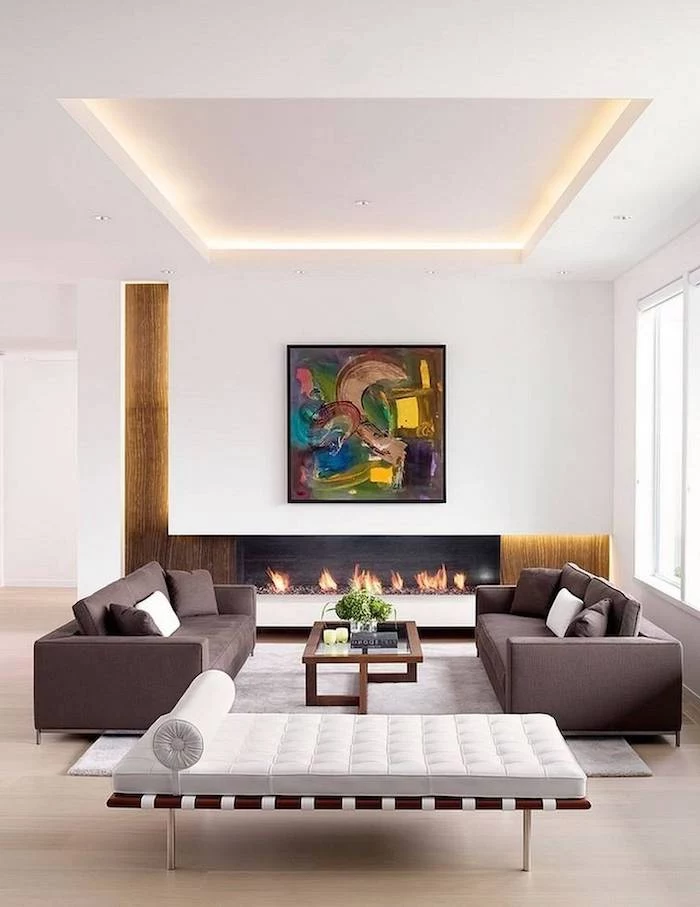
Crucial detail: Don’t neglect the ‘fifth wall’—the ceiling. Painting it a color other than standard white can have a dramatic effect. A dark color like charcoal or navy in a room with high ceilings can create a cozy, intimate feeling. A very pale blue can mimic the sky and make the room feel more open. Even a high-gloss finish in the same color as the walls can add an unexpected touch of glamour.
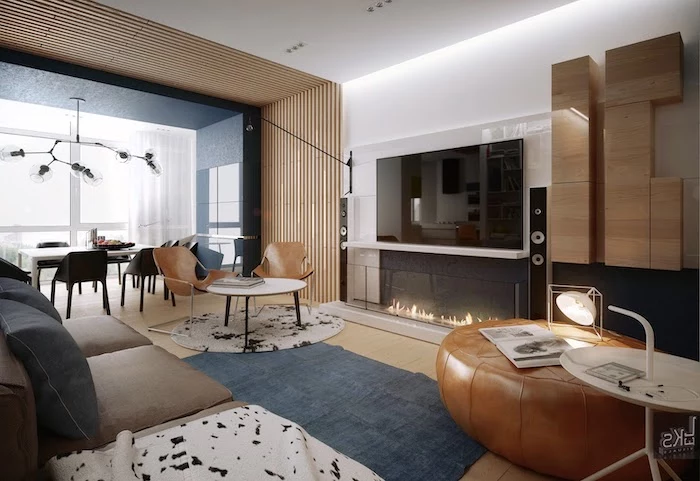
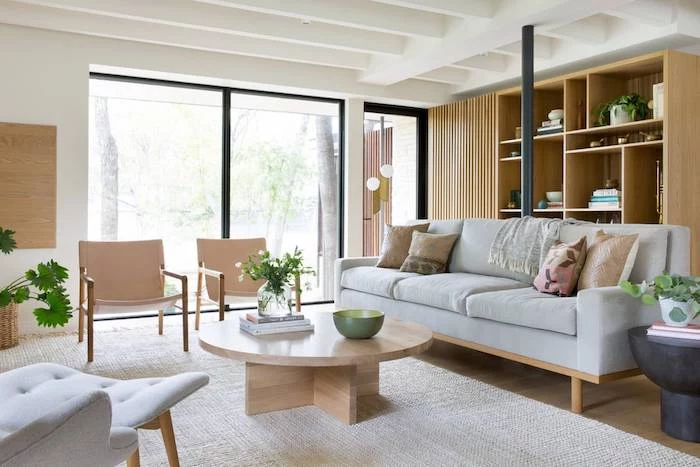
For an optimal viewing experience, the recommended distance between your sofa and a 4K TV is 1 to 1.5 times the screen’s diagonal size.
This means for a 65-inch TV, your sofa should be positioned between 65 and 97.5 inches away. Placing your seating based on this simple formula, rather than just pushing it against the farthest wall, ensures a comfortable, cinematic experience and often results in a more intimate and functional furniture arrangement.
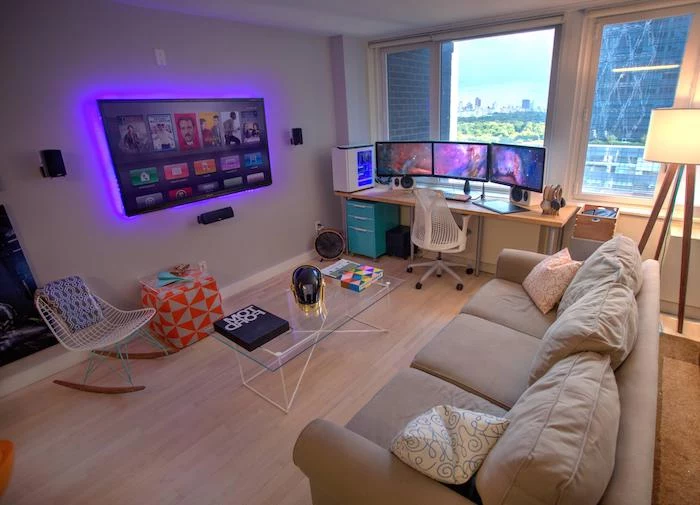
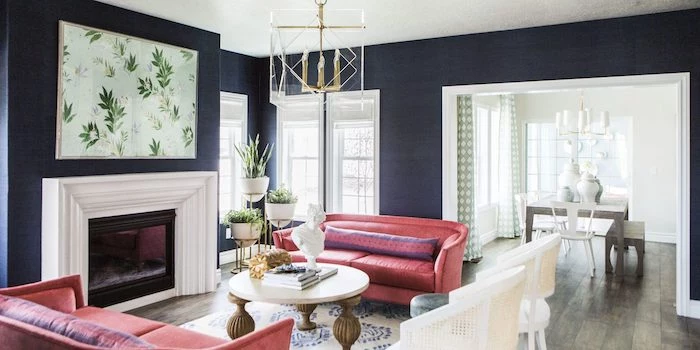
Want an instant, high-impact update on a tight budget? Focus on textiles.
- Swap out tired throw pillow covers for new ones in a fresh color or pattern from H&M Home or Zara Home.
- Drape a new, richly-textured throw blanket over the arm of your sofa.
- Even a new lampshade can completely change the character of an old lamp base.
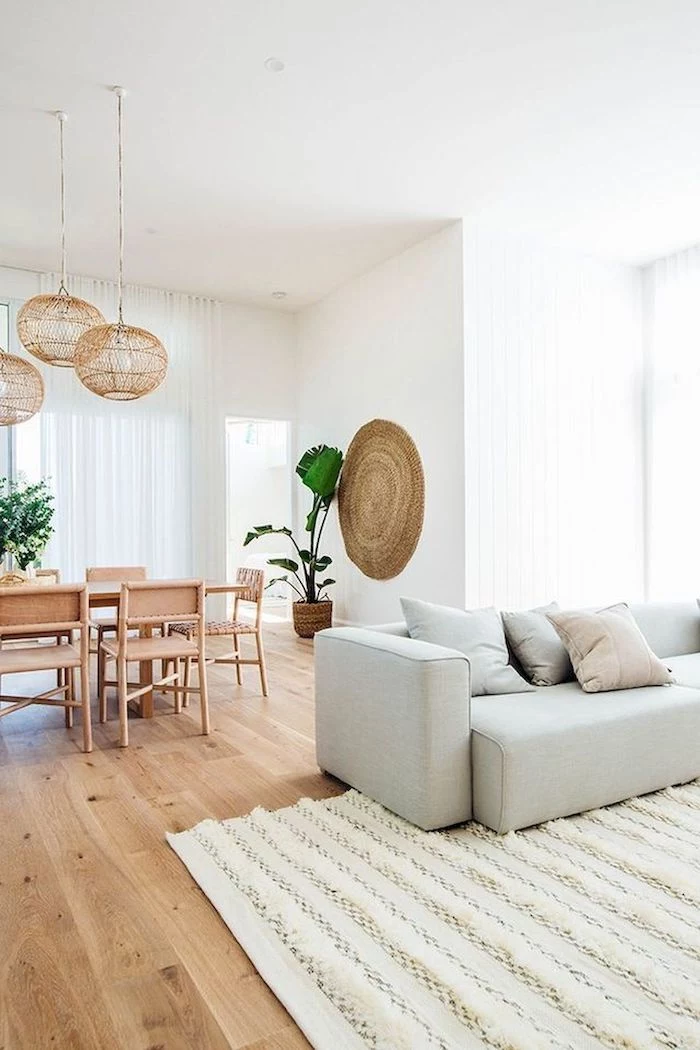
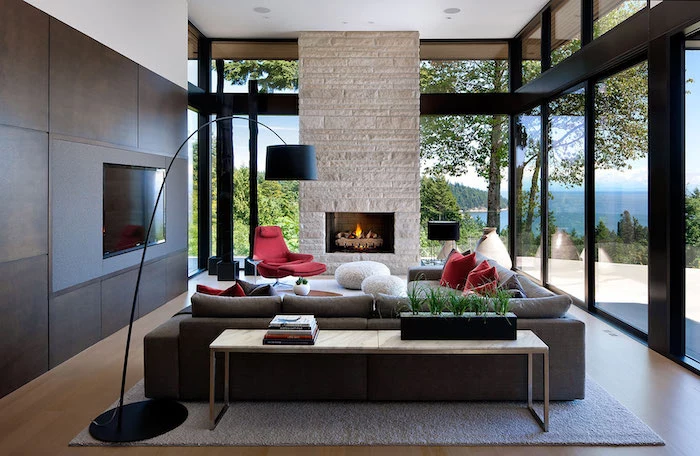
Matte/Flat Finish: This finish has no sheen, which is excellent for hiding imperfections on older walls. It provides a velvety, rich depth of color. However, it’s the least durable and can be difficult to clean, making it better for lower-traffic living rooms.
Eggshell/Satin Finish: With a slight sheen, this is the most popular choice. It’s far more durable and wipeable than matte, reflecting a small amount of light. It offers a great balance of practicality and aesthetics, perfect for most family living rooms.

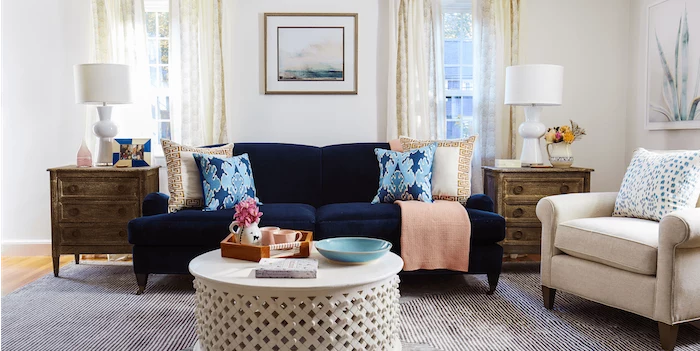
The ‘conversational circle’ is a core principle of good living room design. Your main seating pieces—sofa, chairs—should be arranged to face each other, close enough that people can talk without shouting. Ideally, the diameter of this arrangement shouldn’t exceed 8 to 10 feet. This simple guideline encourages interaction and makes the room feel much more welcoming and functional.
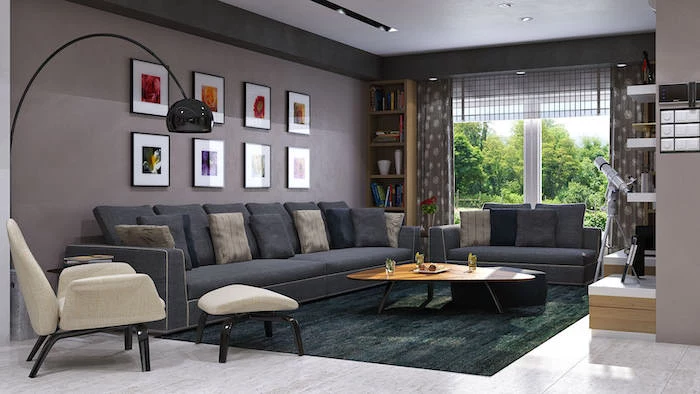
If you have an empty corner that feels awkward, resist the urge to fill it with a generic plant. Instead, create a purposeful ‘vignette.’ Combine a comfortable but not-too-large armchair, a small side table just big enough for a drink and a book, and a slim floor lamp. This ‘reading nook’ transforms a dead space into a functional and inviting destination within the room.


